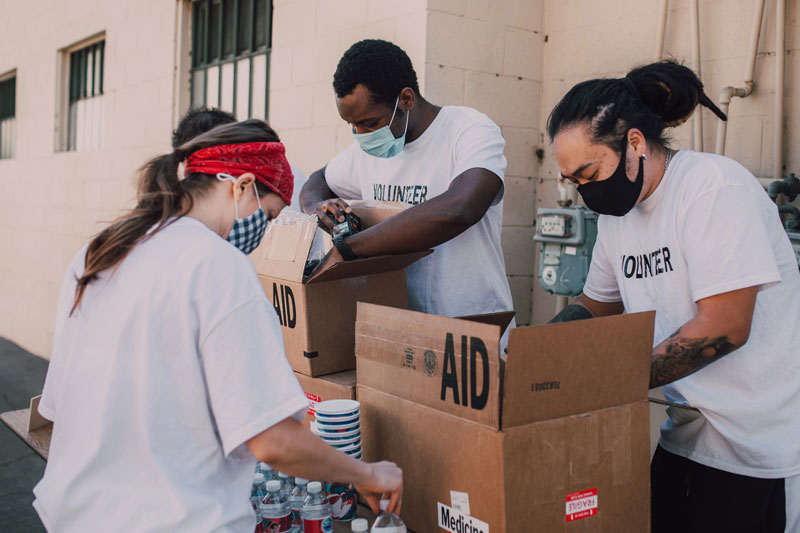
In writing about COVID-19’s impact on the US economy, journalists, economists, and researchers alike have sliced up the for-profit sector by location, size, industry, and myriad other dimensions when searching for and positing answers. Conversely, the nonprofit sector is often treated as a monolith, with catastrophic cases standing in for all nonprofit experience.
While it’s certainly true that many sectors of nonprofits were hard hit, others have moved through the pandemic with relatively little disruption—and some even thrived. A Center for Effective Philanthropy (CEP) report released in June 2021 noted that more than 30 percent of nonprofits report that the pandemic has had little negative impact to significantly positive impact.
While media accounts of nonprofits all too often smother difference, they are particularly damaging in this moment, as people try to understand where to direct resources and learn from those closest to the solutions. US nonprofits make up about 5.6 percent of GDP (gross domestic product) and represent about 10 percent of employment. The mission, size, and geographic focus of the sector is as varied as the for-profit sector, and the impact of the COVID-19 crisis likewise varies profoundly.
During the pandemic, starting in June 2020, the late Lester Salamon and Chelsea Newhouse of the Center for Civil Society Studies at Johns Hopkins began to produce monthly reports that culled federal labor statistics data to understand sectoral trends within the nonprofit sector. The spread revealed is extraordinary. In one such report, issued in February 2021, Salamon and Newhouse found that employment in health sector nonprofits as of January 2021 was only 3.3 percent below its pre-pandemic peak, while arts employment had fallen 36.3 percent.
For an individual nonprofit, according to the CEP report, COVID-19’s impact correlates most strongly with two factors: 1) program focus (or “industry,” if you will) and 2) the financial reserves the organization had pre-pandemic. Noteworthy here is that neither factor speaks to actual strategic responses by leadership, even though creative responses abound. Evidently, leadership responses are hugely important, even if quantitative data sets often have a difficult time picking up such nuances. Still, these two structural factors frame the field of play in which nonprofits operate and so are reviewed here.
Program Focus
Often, nonprofits operate in a countercyclical fashion to the overall economy, with demand and funding for services rising in response to an economic downturn. Such was the case, for example, during the Great Recession. Still, when you look more closely at different mission and program areas, there is wide variation on how nonprofits fare. This was certainly true amid COVID-19, with the multiple layers of public health, a long-overdue racial reckoning, and economic crisis. Arts organizations, as noted above, suffered the greatest setbacks, with a disproportionate decrease in demand and revenue and the least clear outlook on what comes next.
Meanwhile, community and economic development organizations—a broad sweeping category that includes financial services, housing support, social enterprise, and community improvement—experienced the opposite. These organizations reported a greater public understanding of the need for their services, as well as increased demand and funding. While this peak came with operational challenges, particularly among those who rely on volunteer workers, existential questions around whether they would survive or need to reinvent their program delivery models were less frequent than in other parts of the sector.
Sign up for our free newsletters
Subscribe to NPQ's newsletters to have our top stories delivered directly to your inbox.
By signing up, you agree to our privacy policy and terms of use, and to receive messages from NPQ and our partners.
Between these extremes are those organizations that were seen as less critical (at least by funders) in terms of immediate impact, such as workforce development, capacity building, and other intermediaries. These groups often found themselves losing funding while needing to swiftly reinvent themselves and invest in digitizing their programming.
Organizational Foundation
Another determinant was the organization’s “bench” pre-COVID. Specifically, this refers to a nonprofit’s operating reserve and preexisting unrestricted grant commitments to support the quick pivots that many organizations needed to make during COVID, regardless of industry, whether it entailed increasing services to meet a surge in need, bringing programs to a virtual environment, or replacing a volunteer workforce. Those unexpected investments are made possible through an organization’s reserves—particularly when staff and volunteer capabilities are restricted.
It’s surely no surprise that BIPOC-led organizations reported smaller operating budgets and fewer unrestricted net assets. The short-term grant cycle that was unsustainable before COVID-19 became nearly impossible for many.
Prior to George Floyd’s murder and the mass movement against anti-Black racism that arose in response, many Black-led nonprofits were being neglected, even as the Black community was hit extremely hard by the virus. A Building Movement Project study surveyed 433 BIPOC leaders (39 percent of whom were Black) in May 2020. In that survey, 46 percent of surveyed Black leaders reported a decline in grant funding, while only 23 percent reported an increase, with the remainder reporting no change.
Even after the uprising that followed Floyd’s murder, funder response was uneven. CEP reports that 55 percent of funders increased funding to support Black and Latinx communities, compared to only 19 percent for Middle Eastern communities and 29 percent for Asian communities. And while CEP found that government relief, such as PPP (Paycheck Protection Program) and other programs, helped ensure nonprofits took less damage than they otherwise would have, the future financial sustainability of many nonprofits remains unclear. This is especially the case for nonprofits that are led by and serve people of color.
Moving Forward
The COVID-19 pandemic, of course, is not over. For nonprofits and philanthropy to respond effectively, it is critical to have a clear picture of the terrain.
Data is a vital starting point, but it is only useful if acted upon. Clearly, nonprofit leaders in hard-hit sectors must articulate their needs—and many are doing so. But donors and philanthropy must also pay attention and be responsive to those calls.











